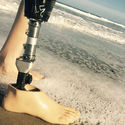Putting his best foot forward for others
Dr. Les Kramer of Longwood was a man "behind" his times-that is to say he is a man who finds technical solutions to meet national needs during changing times. He was a flexible person, and adjusted his career goals during his 46-year science and engineering career. This flexibility eventually led him to become the vice president of engineering at TaiLor Made Prosthetics, where he is a designer and developer of a prosthetic foot more flexible than any other prosthetic on the market.
Kramer grew up on the south side of Chicago in South Shore, a predominantly Jewish community. Graduates from his high school included Nobel prize winner James Watson, one of the co-discoverers of the structure of DNA; Larry Ellison, co-founder of Oracle, a leading software corporation; and the actor Mandy Patinkin. Just watch, soon Kramer will join this list of famous people.
As a child, Kramer's father taught him how to use tools and build things, and as a result, Kramer was always entering science fairs. At the start of World War II, his father was ranked 4F, so the military put his dad into engineering school to help the war effort. When the war ended, so did his schooling, and the old college textbooks were put on the shelf until Kramer found them. So began his interest in metallurgy at age 11.
When he began college at the University of Illinois, he wanted to be a steel-mill metallurgist. By the time he finished his bachelor's, steel mill industry was dying. During a summer internship in Pennsylvania, he met a professor from the material science department at Penn State who advised him to transition from metallurgical engineering to material science.
Kramer decided to go to Penn State for graduate work and to "be warmer." Seems the cold winds of Chicago were encouragement enough for Kramer to move over to the "warmer climate" of Pennsylvania (because of the mountains that blocked the cold winds).
Penn State is also where Kramer met his wife, Lynn, on a blind date. He eventually cinched the relationship by giving her half his fortune in Jewish ethnic food he'd gotten while on a trip to Philadelphia. They both realized the relationship was meant to be when he invited her to his dorm room, which turned out to be the room she had just vacated. They have been together now for 49 years, and raised two children.
Back to Kramer's careers. After sending out 200 resumes, and on a deadline to complete his thesis, he landed a job with Westinghouse Electric Corporation "just in the nick of time." Within 90 days, Kramer completed his thesis and passed his defense-a feat unheard of by his professor-and moved to Wilmington, Del., to work for Westinghouse in Philadelphia, where he became the manager of the Steam Turbine Materials Engineering department. After 14 years with Westinghouse, where he absolutely loved his job, Kramer took a research position with Martin Marietta Aerospace in Orlando, where he became a senior engineer in the Research and Technology department.
A few years later, Martin Marietta had a contract to co-develop the Javelin missile. It had to be no more than 25 pounds. Too much metal caused the missile to exceed the weight requirement, so by doing research on custom injection molded plastics, he was able to make some of the internal structure, the wings and fins out of molded plastic, thus bringing the weight of the missile down below 25 pounds.
"This was probably the biggest success in my career as far as making a major program really be successful," he said.
He shared that while attending a meeting in London, he sat with a couple marines whom he was introduced to as part of the development team of the Javelin missile. "They were really excited because they love it. It saved many American lives."
Shortly after this, Kramer went strictly into research at Lockheed Martin. This led him down many paths and the opportunity to work with leading scientists. He wrote a proposal with Nobel Prize winner Alan Heeger, and he worked with Chemistry Physics Nobel winner Dr. Richard Smalley, co-discoverer of Buckminister Fullerenes, (an allotrope of carbon that consists of 60 carbon atoms in the shape of a soccer ball, nicknamed "buckyball").
"Dr. Smalley got me into using nano materials to do all sorts of structural things like changing shapes," Kramer stated. This resulted in Kramer becoming the director and chief technologist at Lockheed.
One other interesting tidbit about Kramer's research and engineering exploits is that he was the chief scientist of a renewable energy project called Ocean Thermal Energy Conversion. OTEC is a process that can produce electricity by using the temperature difference between deep cold ocean water and warm tropical surface waters. OTEC plants pump large quantities of deep cold seawater and surface seawater to run a power cycle and produce electricity. The world will be hearing more about this energy producing system in the future.
In 2010, Lynn began to suggest to Kramer that he retire. After so many accomplishments-14 patents and 13 awards (including the Nunn-Perry Award from the U.S. Office of the Secretary of Defense and the American Society of Mechanical Engineers Silver Medal)-he agreed that he was ready to retire. But after looking over his wife's calendar and seeing that she was so active, he realized there was not a lot of time in her schedule for him. So for a while, Kramer went out with friends, fiddled with woodworking and amateur radio (he had been a Ham radio operator for over 58 years). Within 60 days of retirement he started a research and consulting company, and within 60 days of formation, they had a contract dealing with nano materials from Florida State University. That led to his team and FSU bidding on a job for lower limb amputee socket development technology, submitted by the U.S. Department of Veterans Affairs.
As Kramer and his partner were designing the U.S. VA contract prosthesis, they started casually talking about the need for a new prosthetic foot. Kramer subsequently developed the concept foot prototype. "As we tried the prototype foot on many amputees, we immediately realized that the foot was a remarkable and unique concept. The rest is history," he said.
What Kramer had learned in the aerospace industry transitioned into the prosthetic foot and TaiLor Made Prosthetics, LLC was created.
"It is TaiLor Made because the foot can be tailor made to the person," Kramer said with a smile.
The same black carbon fiber used in airplanes is used in the prosthetic foot he designed.
Kramer lights up when he discusses composites. "Metals have certain properties, but the beauty of composites depends on where you put the fibers for strength in the foot. We want it to be stiff in one direction. Different parts have different stiffness for different feet," he explained.
All the other prosthetic feet on the market today either are bolted or glued together. The TaiLor Made (TLM) prosthetic foot is designed with toe and heel elements that move independently along with a shock absorbing mechanical spring pack, called the Control Hub, which houses vertical shock springs allowing for easy in-clinic customization. The design of independent heel and forefoot movement with shock absorption enables ankle motion and ground conformance resulting in excellent stability, performance and comfort. Kramer currently has three patents on the foot and one in the works.
Because of the TLM foot design, activities like weight-lifting, surfing, skateboarding, zip-lining, and mountain climbing can be resumed.
"I guess all I needed was a TaiLor Made foot and a pair of P.F. Flyers Hi-Tops. Now I can run faster and jump higher!" exclaimed one TLM wearer.
Celeste Corcoran, a Boston Marathon victim uses the TLM prosthetic. She was not a runner, but was watching her sister run. She lost parts of both legs.
Kramer is also developing a pediatric prosthetic. One 10-year-old cheerleader who wanted more mobility in her prosthetic foot, heard about TLM. The TLM team adapted an adult Control Hub and cut adult parts down to pediatric size and it worked. She can do flips and cartwheels with no problem now.
Another unique feature of the TLM prosthetic is that amputees can now walk backwards, something that could not be done before.
A woman in her 60s said on TLM's Facebook page the invention of the TaiLor Made foot has added "an invaluable dimension to my life."
"With this foot and its technology, the ease of walking and having a natural gait are immediately apparent," she said. "Another positive and equally important benefit is that this foot enables me to stand in a more natural position putting less stress on my sound knee and hip."
Sometimes it's the little things in life that mean the most. Women with the TLM foot can now wear heels. Kramer designed a shorter heel that can accommodate a 3-inch wedge.
TLM has entered an exclusive agreement with Ottobock, a global leader in orthotic and prosthetic products. Established in 1919 in Germany, this privately held company offers products to help people maintain or regain their freedom of movement.
There will be no stopping Kramer's fancy footwork now for many amputees worldwide.















Reader Comments(0)